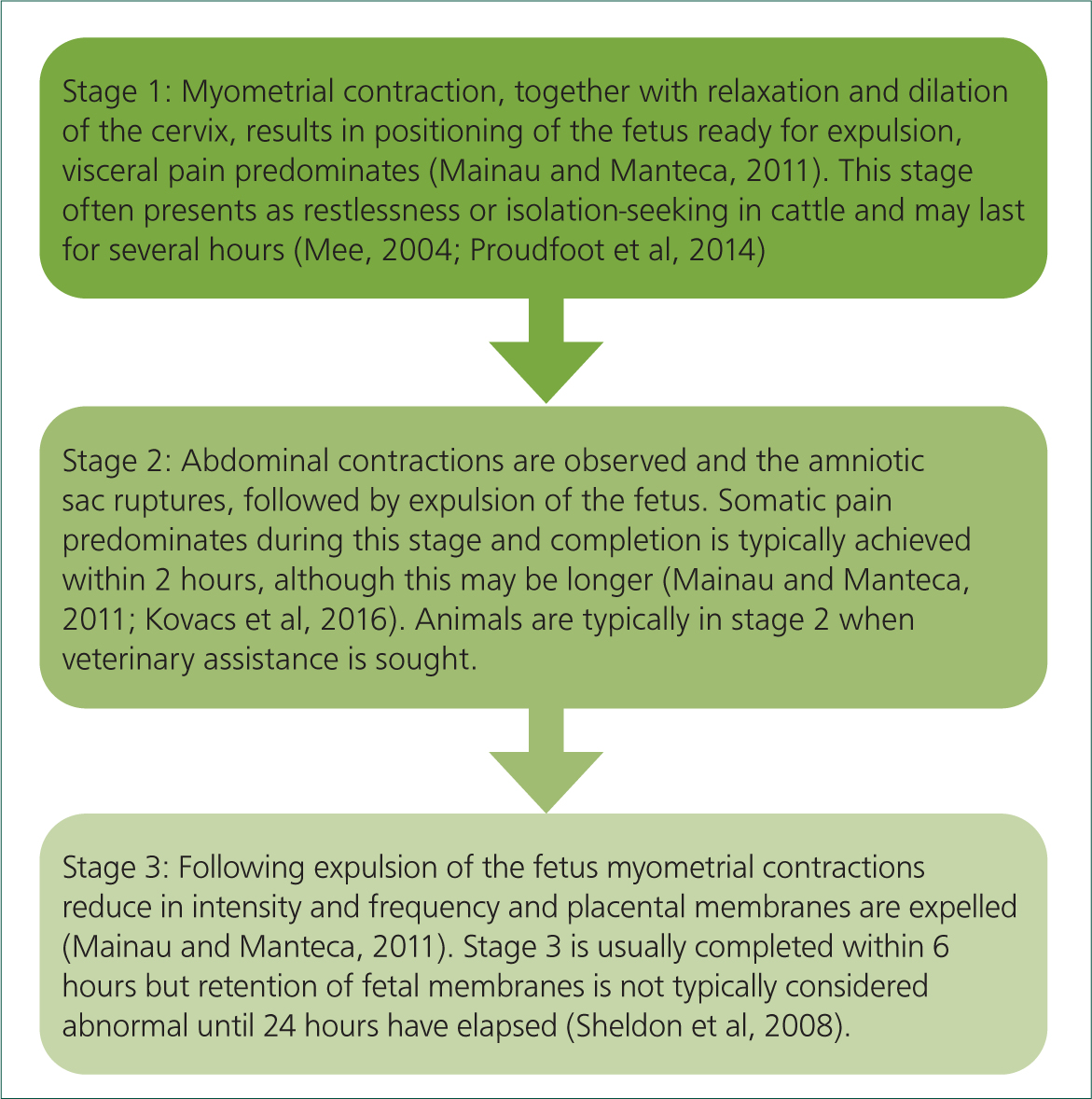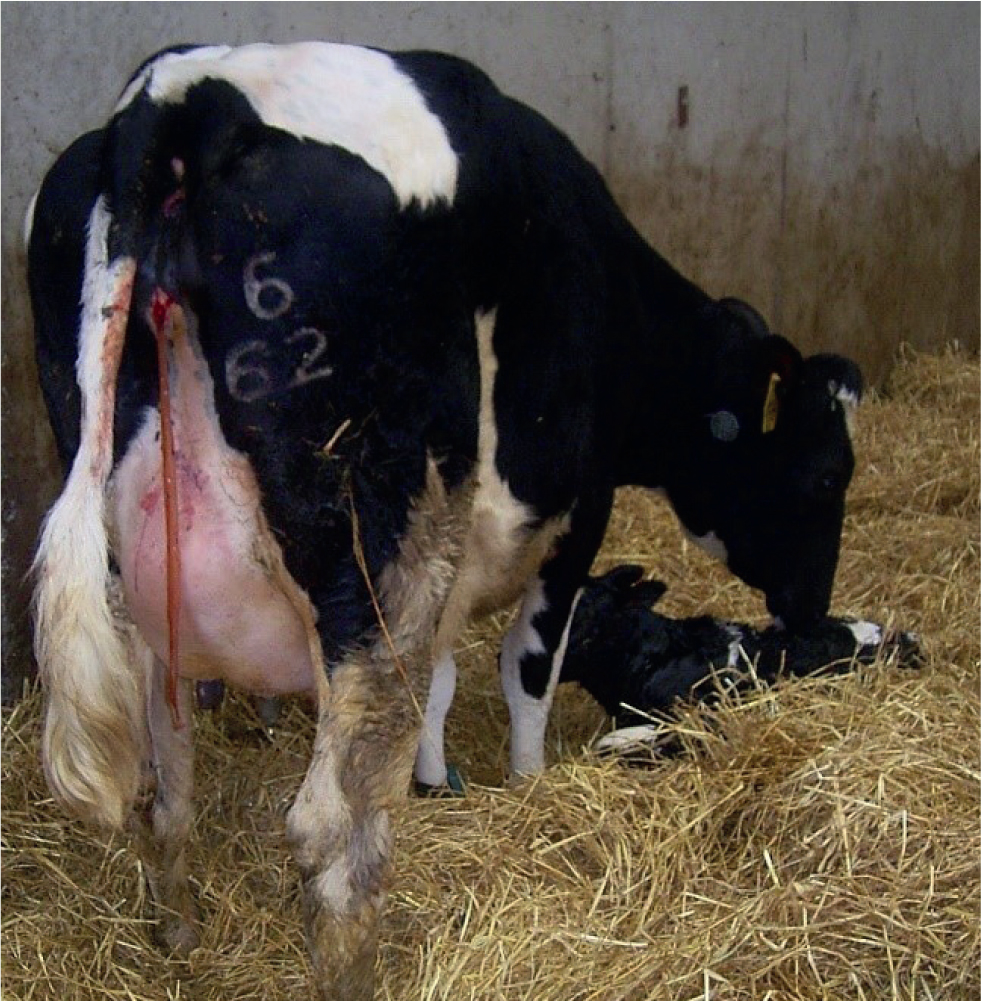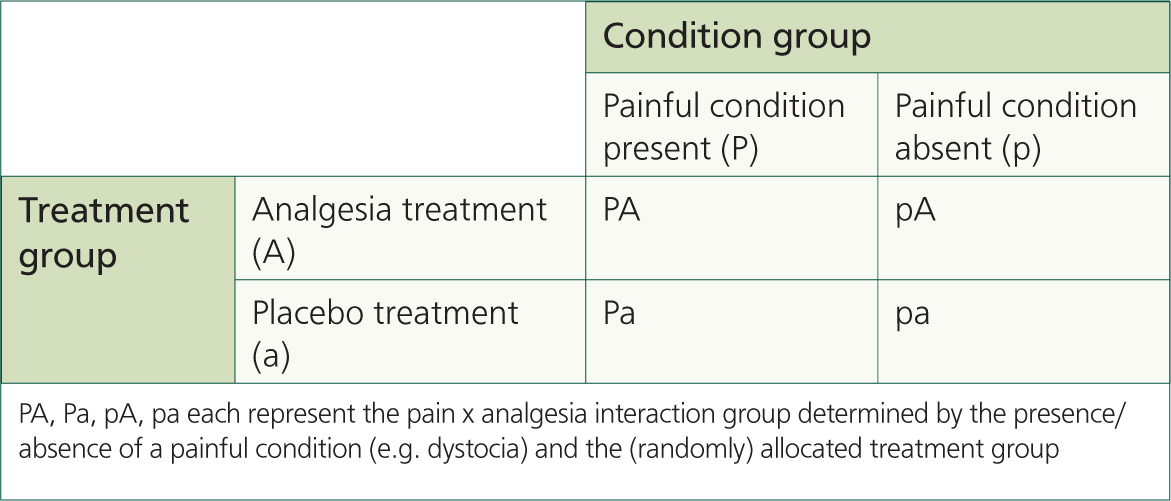Calving is a necessary event for productive cows; assisted parturition is common and is most frequently performed by farmers (Egan et al, 2001). While difficult calving is believed to be painful and stressful for cows and their calves, data to support this view are limited. Previous studies have found that veterinary surgeons and farmers often administer analgesia to cows, and less commonly calves, following assisted parturition (Laven et al, 2009; Moggy et al, 2017; Remnant et al, 2017). However, results of existing studies investigating analgesia administration after calving are conflicting and very few studies report analgesia effects in newborn calves. As such, while it is well described that cattle experiencing painful conditions, or following surgery, benefit from provision of analgesia (Coetzee, 2013; Herskin and Nielsen, 2018), the benefits of analgesic usage at calving are less clear. This article aims to review the literature on analgesia usage around calving to aid practitioners in making evidence-based decisions regarding management of calving-related pain in cows and calves. For a more general overview of bovine analgesia, readers are referred to relevant reviews in this journal and elsewhere (e.g. Orr et al, 2014; Laven, 2020; Reader et al, 2020; Steagall et al, 2021).
Calving and pain
Calving is a complex process with three recognised stages (Figures 1 and 2), each associated with different sources of pain. Pain is a subjective experience defined by the International Association for the Study of Pain as ‘an unpleasant sensory and emotional experience associated with, or resembling that associated with, actual or potential tissue damage’ (Loeser et al, 2008: 475). In human medicine childbirth is recognised to be very painful, and it is known that women experience postpartum pain related to normal uterine involution (Deussen et al, 2020). By contrast, calving pain is poorly researched in cattle and it is unclear if cattle also experience postpartum pain in normal circumstances, or only following calving injury; although recent research suggests that discomfort following calving is experienced by all cattle, regardless of calving experience (Gladden et al, 2021). Moreover, pain experienced by calves during (or immediately after) birth is rarely studied (Laven et al, 2012). Interestingly, veterinary surgeons typically consider neonatal calves to experience less pain than adult cattle, even following dystocia (Huxley et al, 2007; Laven et al, 2009; Remnant et al, 2017), and accordingly analgesic use following painful procedures is more common in adult cattle than calves (Andrighetto Canozzi et al, 2020); however, data to support this belief are absent. Moreover, newborn babies have been found to experience pain similarly to adults (Goksan et al, 2015), and substantial forces are applied to calves during assisted birth (Pearson et al, 2020); therefore, it is likely that newborn calves experience pain at birth (in particular if assisted), and this needs to be considered by practitioners.


Bovine analgesia
Bovine pain has been subject to increased interest in recent decades, and it is now well-recognised by farmers and veterinary surgeons that cattle experience pain (Whay et al, 2005; Huxley et al, 2007; Laven et al, 2009; Thomsen et al, 2012; Remnant et al, 2017). The most commonly used analgesic drugs in cattle practice are non-steroidal anti-inflammatory drugs (NSAIDs); only this category of analgesic drugs have been investigated in the peri-partum period, therefore this article focuses on this type of analgesia. As well as providing analgesia, NSAIDs have anti-inflammatory and antipyretic properties, and share a common mechanism of action: cyclo-oxygenase (COX) enzyme inhibition, resulting in prostaglandin and thromboxane inhibition (Smith and Willis, 1971; Vane, 1971). Detailed discussion of NSAIDs is outwith the scope of this article but can be found elsewhere (Laven, 2020), and a selection of products licensed for use in cattle in the UK are summarised in Table 1.
Table 1. Non-steroidal anti-inflammatory drugs (NSAIDs) available for use in UK cattle practice1
| NSAID | Commercial products | Licensed route | Dose rate | Withdrawal period | |
|---|---|---|---|---|---|
| Milk | Meat | ||||
| Carprofen | Carprieve (Norbrook)Rimadyl (Zoetis) | IV, SC | 1.4 mg/kg (1 ml/35 kg) | 0 h | 21 d |
| Flunixin2 | Allevinix (Ceva) | IV, IM | 2 mg/kg (2 ml/50 kg) | 24 h (IV)/36 h (IM) | 10 d (IV)/31 d (IM) |
| Cronyxin (Bimeda) | IV | 2.2 mg/kg (2 ml/45 kg) | 12 h | 8 d | |
| Finadyne transdermal (MSD) | Transdermal (pour-on) | 3.33 mg/kg (1 ml/15 kg) | 36 h | 7 d | |
| Finadyne (MSD) | IV | 2.2 mg/kg (2 ml/45 kg) | 24 h | 5 d | |
| Pyroflam (Norbrook | IV | 2.2 mg/kg (2 ml/45 kg) | 24 h | 10 d | |
| Ketoprofen2 | Dinalgen (Elanco) | IV, IM | 3 mg/kg (1 ml/50 kg) | 0 h | 2 d |
| Ketofen (Ceva)Ketodolor (Virbac) | IV, IM | 3 mg/kg (3 ml/100 kg) | 0 h | 1 d (IV)/4 d (IM) | |
| Nefotek (Bimeda)Rifen (Chanelle Pharma) | IV, IM | 3 mg/kg (3 ml/100 kg) | 0 h | 4 d | |
| Meloxicam2 | Inflacam (Virbac)Loxicom (Norbrook)Meloxidyl (Ceva)Metacam 20mg/ml (Boehringer Ingelheim)Rheumocam (Chanelle Pharma) | IV, SC | 0.5 mg/kg (2.5 ml/100 kg) | 5 d120 h | 15 d15 d |
| Metacam 40 mg/ml (Boehringer Ingelheim) | IV, SC | 0.5 mg/kg (1.25 ml/100 kg) | 120 h | 15 d | |
| Meloxidolor (Dechra) | IV, SC | 0.5 mg/kg (2.5 ml/100 kg) | Not available | 15 d | |
| Sodium salicylate | Solacyl (Dechra) | PO (in milk or water) | 40 mg/kg | Not licensed for use in lactating cows | 0 d |
IV = intravenous. IM = intramuscular. SC = subcutaneous. PO = per os.
Information correct at the time of writing – the authors accept no responsibility regarding the use of these products. Readers are recommended to refer to relevant product datasheets.
1.List is restricted to products appearing in the NOAH compendium (National Office of Animal Health, 2022) and is not exhaustive.
2.Available antibiotic/NSAID combination products are not included
Health and productivity effects of non-steroidal anti-inflammatory drug (NSAID) administration at calving
Although an inflammatory response is a normal finding in post-partum cattle, this response is greater in cattle that subsequently go on to develop postpartum disease (Humblet et al, 2006; Qu et al, 2014). Accordingly, there has been interest in the potential for NSAIDs to reduce the risk of postpartum disease. Findings at a biochemical level have been promising, with postpartum NSAID administration being associated with reduced serum haptoglobin and β-hydroxybutyrate concentration (Barragan et al, 2020a; Pascottini et al, 2020), but a consistent improvement in clinical disease outcomes has not been shown. Use of different NSAIDs in various studies may be one factor contributing to the inconsistent findings reported. For example, Barragan et al (2021) administered two doses of acetylsalicylic acid (Aspirin) to cows 12 and 24 hours after calving, and found that NSAID treated cows had a lower risk of developing metritis, but this finding was not supported by the results of Richards et al (2009), who found no effect of ketoprofen on postpartum disease status.
There has been concern over the possible negative effects of NSAID administration around calving, with particular focus on the increased risk of retained fetal membranes (RFM). As prostaglandins are important in the postpartum period for placental expulsion, these concerns are not unfounded. Different NSAIDs appear to have variable effects on placental retention. More than 20 years ago a study associated flunixin administration with increased RFM risk following Caesarean-section (Waelchli et al, 1999), but did not include animals that calved per vaginum. More recently, this finding has been supported by a study of unassisted calvings that found flunixin administration was associated with not just an increased risk of RFM, but also an increased risk of stillbirth (Newby et al, 2017). However an absence of negative effects of other NSAIDs has been reported, with studies investigating effects of ketoprofen, meloxicam and acetylsalicylic acid all finding no difference between NSAID-treated and untreated or placebo-treated animals (Richards et al, 2009; Swartz et al, 2018; Barragan et al, 2021).
Results of studies investigating the effects of NSAID administration (at calving) on subsequent productivity are mixed; however, the different NSAIDs used, and different measures of milk production analysed, makes comparisons between studies difficult. Most studies analysing the effects of meloxicam, carprofen, flunixin and ketoprofen have found that milk production is not affected by NSAID administration (Richards et al, 2009; Shwartz et al, 2009; Newby et al, 2013; Mainau et al, 2014; Meier et al, 2014); however, these studies are restricted to short-term measures. Studies analysing longer-term measures of milk production (such as 305-day yield) are fewer, but provide more promising results — suggesting NSAID treatment may be associated with improvements in milk production (Farney et al, 2013; Stilwell et al, 2014) — a finding supported by the authors' recent work (Gladden, 2021). Milk production is affected by many factors and some studies have found that NSAID administration interacts with other factors affecting milk yield. For example, Farney et al (2013) found that sodium salicylate treatment at calving was associated with increased 305-day yield of cows in the third lactation and over, but not younger cows. By contrast, Stilwell et al (2014) found that milk yield at 305 days in milk (DIM) was increased in heifers treated with carprofen (compared with untreated heifers), but milk yield of carprofen-treated multiparous cows at 305 DIM was no different to untreated cows.
Persistent postpartum inflammation is associated with delayed ovarian resumption (Cheong et al, 2017), therefore it is possible that NSAID treatment at calving may be associated with improved reproductive performance in the subsequent lactation. Few studies have analysed the effects of NSAID treatment at calving on subsequent lactation performance; however, the limited available data are promising. Acetylsalicylic acid treatment has been associated with improved reproductive performance, with treated cows conceiving sooner and needing fewer insemination attempts to conceive than placebo-treated cows (Barragan et al, 2020b, 2021). Acetylsalicylic acid is not licensed for use in adult cattle in the UK, but the results of the authors' study suggested that ketoprofen treatment has a similar beneficial effect (Gladden, 2021).
Welfare effects of non-steroidal anti-inflammatory drug administration at calving
The limited number of studies on NSAID treatment at calving suggest welfare is improved if NSAIDs are administered. For example, the authors recently observed that ketoprofen-treated cattle engaged in lying postures consistent with improved comfort more than placebo-treated cattle (Gladden et al, 2021). Additionally, previous studies have found NSAID-treated cows are more active, and engage in feeding directed behaviours more frequently, than untreated or placebo-treated cows (Newby et al, 2013; Mainau et al, 2014; Stilwell et al, 2014; Barragan et al, 2020b). Furthermore, a recent study has found that, although NSAID treatment was provided 24 hours after calving, behavioural signs of postpartum pain (such as back-arching and tail lifting) of NSAID-treated cows were reduced compared with placebo-treated cows (Schmitt et al, 2022). Collectively, these results strongly suggest NSAID administration at, or soon after, calving has a positive impact on postpartum welfare of cattle, and routine use should be considered by farmers and veterinary surgeons seeking to optimise postpartum welfare.
Difficult calving
It is often thought that dystocia is more painful than unassisted calving, but data to support this view are limited. A factorial study design including analgesia-treated and placebo-treated animals, as well as animals affected by a painful experience and unaffected control animals, in a 2 x 2 design (Figure 3), is considered optimal for assessment of animal pain (Weary et al, 2006). This type of study design allows determination of whether an observed difference in measured outcomes is a) related to the painful experience and b) ameliorated by analgesia (suggesting that pain is the source of the change in outcome). However, this type of study design is rarely used in studies of postpartum pain in cattle, with only three studies (reported across five publications) employing a factorial design (Gladden et al, 2018, 2021; Swartz et al, 2018; Barragan et al, 2020a, 2020b). The authors did not identify any effects of the interaction between calving assistance and NSAID treatment on biomarkers of stress and inflammation or postpartum behaviour (Gladden et al, 2018, 2021), although an interaction effect on some measures of productivity were identified (Gladden et al. unpublished data). Swartz et al (2018) found that the daily milk yield of cows experiencing eutocia (unconventionally defined as calving lasting ≤ 70 minutes) that were treated with a NSAID before calving was nearly 7 kg/day higher than cows in other calving type x NSAID treatment groups. By contrast, Barragan et al (2020b) measured daily milk yield for 30 days postpartum and found that milk yield on some days was higher for NSAID-treated cows in the dystocia group, but there was no treatment effect on unassisted cows. Similar to the authors' study (Gladden et al, 2018), Barragan et al (2020a) did not identify any assistance x treatment interaction effects on biomarkers of stress, inflammation, or nociception. As such, it is unclear whether assisted cows (or cows experiencing dystocia) experience different effects of NSAID administration to unassisted cows, and further work is needed.

Administration of NSAIDs to newborn calves
Few studies have investigated the effects of post-birth analgesic treatment of newborn calves; however, the available data suggest that NSAIDs show promise as an additional tool for improving calf health and welfare. Post-birth meloxicam treatment has been associated with increased vigour (Murray et al, 2016), improved feed consumption (Murray et al, 2016; Clark et al, 2020), and improved early-life growth rate (Pearson et al, 2019). Similarly, ketoprofen administration immediately after birth was associated with increased engagement in behaviours consistent with improved welfare (Gladden et al, 2019).
The use of NSAIDs in newborn calves is off-licence for all products available in the UK, and consideration needs to be paid to potential risks of use in such young animals. The effects of NSAIDs on renal development of young calves has not been studied; however, although COX-2 selective inhibitors have been found to affect renal development of mouse pups, COX-1 inhibitors have not been found to have the same effect (Kömhoff et al, 2000). At birth, bovine renal function is thought to be similar to that of adults (Dalton, 1968), which may reduce the nephrotoxic-associated risks posed by NSAIDs. This hypothesis is supported by Pearson et al (2019), who did not find any differences in renal and hepatic parameters of meloxicam and placebo-treated calves. Additionally, the authors' work did not identify any clinically adverse effects of ketoprofen administration to newborn calves compared with a saline treatment (Gladden, 2021). Nevertheless, cattle practitioners should adopt a risk-based approach when administering NSAIDs to young, potentially compromised calves after a dystocia event as, although no studies report adverse effects, all studies only include clinically healthy calves.
Conclusion
This article provides an overview of the currently available evidence for administration of NSAIDs to parturient cows and new-born calves. Although results of different studies are sometimes conflicting, when assessed collectively the data generally support NSAID treatment of cows at calving — particularly from a welfare perspective, where the evidence supporting its use is most consistent. Furthermore, there is evidence that newborn calf welfare is also improved by NSAID administration.
NSAIDs are widely available to bovine practitioners in the UK and are a cost-effective tool with the capacity to aid improvements in the welfare of postpartum cattle. Additionally, there is the potential for productivity gains to be made, which may incentivise use. The wide availability, overall beneficial impact, and limited adverse effects reported, mean that administration of NSAIDs at calving (with the exception of flunixin) can be recommended to veterinary practitioners and farmers seeking to optimise the care of parturient cattle and newborn calves.
KEY POINTS
- Analgesia is under-used around calving, particularly for treatment of calves.
- There is increasing evidence that calving is painful for both cow and calf. Available data strongly suggest that non-steroidal anti-inflammatory (NSAID) pain-relief leads to improved welfare of both cows and calves in the postpartum period.
- Postpartum treatment of cows with NSAIDs has the potential to result in productivity gains, which may incentivise use.
- Evidence for adverse effects is limited and appears to be NSAID specific.
- Administration of NSAIDs at calving is recommended for veterinary practitioners and farmers seeking to optimise the care of parturient cattle and newborn calves.


